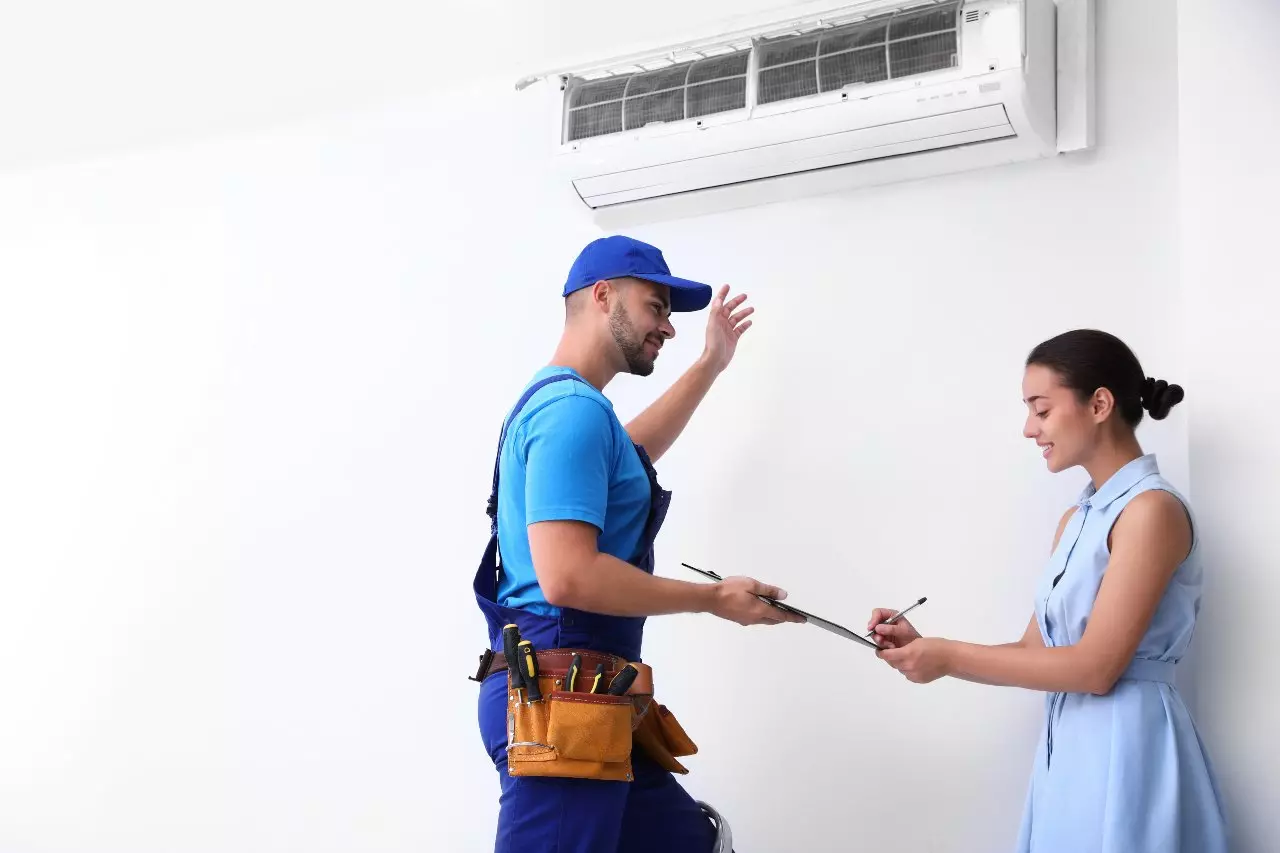Table of Contents
- Is Starting an HVAC Business a Good Idea?
- Starting an HVAC Company: Step-by-Step Guide
- Research the HVAC Industry and Its Trends
- Obtain Licenses and Certifications
- Choose The Perfect HVAC Company Name
- Register Your Business
- Secure Financing
- Get Bonding and Insurance
- Decide on Services and Pricing Structure
- Purchase HVAC Tools and Equipment
- Hire HVAC Technicians
- Create a Professional Website
- Develop a Marketing Strategy
- Leverage Modern Solutions
- Final Thoughts
The journey of Carrier Corporation from its humble beginnings to becoming a titan in the HVAC industry is a blueprint for aspiring entrepreneurs looking to carve out their own path in this lucrative field.
Founded by Willis Carrier in 1915, Carrier began its growth with a groundbreaking idea and a vision for the future – the “Apparatus for Treating Air” (the modern-day air conditioning system). Through relentless innovation and a commitment to quality, Carrier transformed from a small startup into an international leader.
Whether you’re an experienced HVAC technician ready to venture out on your own or an entrepreneur drawn to a growing industry, continue reading to learn how to launch your HVAC business.
Is Starting an HVAC Business a Good Idea?
Yes, the HVAC industry is a growing industry with high earning potential. The U.S. HVAC industry is valued at $19.75 billion and is on an upward trajectory, with a projected growth rate of 6.6% between 2024 and 2029.

As of 2023, over 100,000 U.S. HVAC companies employed roughly 660,000 technicians. Similar to estimated industry growth projections, businesses and employment are also expected to grow by 2031.
When it comes to revenue, the average HVAC company’s financial performance is influenced by its size, time in business, and geographic location. While most HVAC companies report annual revenues of less than $1 million, the typical owner of an HVAC business may earn around $131,000 a year.
Starting an HVAC Company: Step-by-Step Guide
Given the projected growth for the HVAC industry and revenue potential, many opportunities are available for aspiring entrepreneurs to enter the field. Here’s how to start an HVAC business:
Research the HVAC Industry and Its Trends
Launching an HVAC business starts with a deep dive into the industry’s landscape to help you understand what services are in demand, by whom, and where. The knowledge gained from this research will be your foundation, helping you stand out amongst competitors. Here’s how to research the HVAC industry:
- Demand and Profitability: Use climate data from the National Oceanic and Atmospheric Administration (NOAA) to understand weather patterns affecting demand in your target area. Combine this with economic and employment trends from the U.S. Bureau of Labor Statistics (BLS), particularly the Occupational Outlook Handbook, and consumer spending on home improvements from the U.S. Census Bureau’s Annual Retail Trade Survey to gauge market size and investment willingness.
If you discover your area experiences both extreme heat and cold, and the population varies from high to low income, tailor your services to offer high-efficiency, premium HVAC systems for affluent customers and cost-effective, durable solutions for budget-conscious residents. This dual approach allows you to cater to the broad market’s needs, leveraging periods of peak demand driven by weather extremes. - Location: Choose your service area by employing Geographic Information System (GIS) tools to assess construction activity, housing density, and commercial development. Cross-reference this with demographic data from the U.S. Census Bureau’s American Community Survey to pinpoint regions with aging homes or a high concentration of commercial properties, both of which signify opportunities for HVAC installations and maintenance.
- Competition: Evaluate your competition through searches on Google, Yelp, and the Better Business Bureau. Analyze competitors’ market share, customer reviews, services offered, and branding to understand their strengths and weaknesses and identify market gaps.
- Residential vs. Commercial Clients: For residential insights, examine housing market trends and homeowner expenditures on the U.S. Census Bureau’s Survey of Construction and Home Improvement. For commercial opportunities, review real estate trends and new construction projects via databases like LoopNet or local real estate development boards.
- Customer Preferences, Needs, and Demographics: Analyze online reviews and feedback on Google, Facebook, and Yelp. Identify trends in what customers praise or complain about, such as responsiveness, professionalism, or service and system offerings. Additionally, use demographic information from the U.S. Census Bureau to tailor your marketing and service offerings to the age, income level, and property types predominant in your target area.
Obtain Licenses and Certifications
Before you can register your HVAC business or start offering services, you’ll need to obtain your HVAC or contractor license and become certified. Licensing is mandatory in most states as it ensures compliance with legal standards and instills trust in your clients. It also showcases your expertise and commitment to safety and quality.

Every state’s HVAC license requirement is different, but many require one of the following:
- Journeyman experience and certification
- 2-5 years of practical, hands-on experience
- Apprenticeship
- Technician or mechanical contractor licenses
- Mechanical engineering degree
- 1,000 to 8,000 hours of work experience
While some certifications may not be legally required, they are highly beneficial for building credibility and enhancing your skill set. Certifications can differentiate your business from competitors, demonstrating to customers that you are committed to the highest standards of quality and safety.
Here are some HVAC certifications you can explore:
- The EPA 608 Certification is required for technicians who work with refrigerants. The Environmental Protection Agency (EPA) mandates this certification, and it’s divided into four types based on the size and type of equipment:
- Type I for small appliances
- Type II for high-pressure systems
- The North American Technician Excellence (NATE) certification is not mandatory, but it is recognized industry-wide as a symbol of technical expertise in various HVAC areas, such as air conditioning, heat pumps, gas heating, and commercial refrigeration.
- The Occupational Safety and Health Administration (OSHA) certification offers safety training courses that can help prevent workplace accidents and lower insurance rates.
- The HVAC Excellence certification helps technicians demonstrate their proficiency in specific HVAC fields, such as residential air conditioning, heat pump service, or commercial refrigeration.
Choose The Perfect HVAC Company Name
Once you are licensed and certified, the next step to starting an HVAC company is choosing a business name that is memorable and also reflects your services and brand’s values.
Here are some points to consider when brainstorming HVAC business name ideas:
- Reflect Your Services and Values: Think of HVAC company name ideas that reflect the specific services you offer or the core values of your business. Consider words that convey reliability, comfort, efficiency, or speed.
- Keep It Simple and Memorable: A good HVAC name should be easy to remember, pronounce, and spell. This helps customers recall your business when they need HVAC services and makes it easier for them to recommend you to others.
- Research and Originality: Ensure your chosen name isn’t already in use by another HVAC company, especially in your area. Start by checking your state’s business registry, often found on the Secretary of State’s website. This will tell you if the name has already been taken by another business in your state. Also, conduct a Google search to see if your chosen name is being used in a way that could cause confusion or impact your brand.
- Check for Trademarks: To avoid potential legal complications, search the United States Patent and Trademark Office (USPTO) database for existing trademarks on your potential name. This step is crucial to ensure you’re not infringing on another company’s trademark, which could lead to costly disputes down the line.
- Domain Availability: Use GoDaddy, Namecheap, or Google Domains to check the availability of your chosen name. These sites allow you to enter your desired business name and check if the corresponding domain is available, along with variations and different domain extensions (.com, .net, .biz, etc.).
- Assess Longevity and Scalability: Consider whether your chosen name will still be relevant as your business grows and evolves. Avoid names that are too narrow or tied to a specific geographic location unless you’re certain you won’t expand your services or area of operation. For instance, instead of “Downtown Denver HVAC,” which limits the geographic scope, choose a more scalable name like “MountainPeak HVAC Services,” which allows for expansion beyond Denver.
Register Your Business
After you have chosen the perfect name to represent your HVAC company, you can move on to formally registering it with your state’s regulatory bodies. Getting an HVAC business license is a required step that establishes your company as a legal entity, ensures compliance with all regulations, and sets the foundation for operations and taxation.

Here’s how to register your business:
- Choose Your HVAC Business Structure: First and foremost, pick your HVAC business model: sole proprietorship, Limited Liability Company (LLC), or partnership. This choice affects your legal liabilities, tax obligations, and the overall management of your company.
- Sole proprietorship: This is the simplest structure because the business is owned and operated by one person. This simplicity comes with direct control over decisions, but it also means unlimited personal liability for business debts and obligations. For a solo HVAC technician, this option allows you to establish your business quickly and with fewer formalities.
- Partnership: This model involves two or more people co-owning a business, and liability is shared among the partners. This structure might suit HVAC professionals looking to pool their resources, expertise, and customer base. It’s beneficial for spreading out the startup costs, risks, and responsibilities, but remember, each partner is liable for the actions of the others.
- LLC: The owners or members are not personally liable for business debts, but they protect personal assets. Taxes on business income are passed through to members’ personal tax returns, avoiding corporate tax rates. For an AC business expecting to grow or those with significant investments in tools and equipment, an LLC provides a safety net for personal assets and offers flexibility in management and profit sharing.
- Obtain an Employer Identification Number (EIN): If you choose the LLC or partnership structure or plan to hire employees, you’ll need an EIN for tax administration purposes. You can obtain an EIN through the IRS website free of charge.
- Register with the State: Next, you’ll need to register your HVAC business with your state’s Secretary of State office or a similar agency. This registration process involves filing your business name, structure (e.g., LLC, partnership), and EIN. The specific requirements and the process can vary from state to state, so visiting your state’s official government website is a good starting point.
- Register with State and Local Agencies: Finally, you’ll need to register your HVAC business with your state’s Department of Revenue to ensure you are abiding by your state’s tax obligations. As an HVAC business, the taxes you might be responsible for include sales tax (for parts and possibly service), use tax, and employment taxes if you have employees.
Secure Financing
Starting an HVAC business costs, on average, $2,000 to $10,000 for a small operation. However, costs can quickly rise to over $100,000. While you may have some savings to help with these HVAC startup expenses, you’ll likely need a financing boost to get your company up and running.
Here are some financing options you can explore:
- Term Loan: A term loan is a lump sum of capital that you borrow from a lender, which is paid back over a set period with interest. The predictable monthly payments can help business owners budget and plan their finances effectively. However, potential drawbacks include the need for a strong credit score to secure favorable terms and the possibility of accruing significant interest over the loan’s lifetime.
- Equipment Loan: Equipment loans allow HVAC businesses to acquire necessary equipment without the substantial upfront cost. The equipment, such as fleet vehicles, often serves as collateral for the loan, potentially lowering the risk for the lender and the interest rates for the borrower. On the downside, if the business faces financial difficulties, there is a risk of losing the equipment through repossession.
- Small Business Administration (SBA) Loan: SBA loans are backed by the federal government and designed to assist the launch, growth, and development of small businesses. One of the biggest advantages of SBA loans is their partial guarantee by the government, which reduces the risk for lenders and can make it easier for small businesses to qualify. However, the application process for SBA loans can be lengthy and requires thorough documentation. Additionally, SBA loans often require collateral and a personal guarantee from the business owner.
Get Bonding and Insurance
As a requirement for financing and to protect your company against liabilities, you’ll need to obtain bonding and insurance. Bonding serves as a financial guarantee to your clients, ensuring that the work you perform meets regulatory standards and contractual specifications.

Typically, HVAC businesses will need bonding between $1,000 and $10,000. Not all states require bonding for HVAC businesses, but even if it’s not mandatory, it can enhance your credibility and trustworthiness in the eyes of potential customers.
Insurance, on the other hand, is a must-have for HVAC companies. It protects your business assets and covers liabilities and worker-related risks. The types of insurance you’ll need include:
- General Liability Insurance: Covers third-party claims of bodily injury, property damage, and personal injury, such as false advertising.
- Commercial Property Insurance: If you own or lease a space for your business, it covers your tools, inventory, and office equipment in case of fire, theft, or storm damage.
- Workers’ Compensation Insurance: Covers medical expenses and lost wages for employees injured on the job.
- Commercial Auto Insurance: protects vehicles used for driving to HVAC project sites, covering damage from accidents, theft, or natural disasters.
- Equipment Insurance: Covers the repair or replacement of installation and repair tools, as well as HVAC systems and equipment if they’re stolen, damaged, or lost.
- Professional Liability Insurance: Also known as Errors and Omissions (E&O) insurance, this protects against claims of negligence, mistakes, or failures, such as damage due to improper installation or servicing of HVAC systems.
Decide on Services and Pricing Structure
Once you have the legal and logistical requirements sorted, you can move forward with the practical steps of starting an HVAC business – deciding what services you’ll offer and for how much.
Based on your consumer and competitor analysis, here are the services you can offer:
- Installation Services of new HVAC systems in residential or commercial properties, ranging from air conditioners, furnaces, and heat pumps to ductless mini splits.
- Repair Services for existing HVAC systems, including diagnosing issues, replacing faulty parts, and ensuring systems run efficiently.
- Maintenance Services to keep HVAC systems in top condition, including cleaning, inspections, and routine tune-ups.
- Energy Efficiency Upgrades to upgrade existing systems for improved energy efficiency and reduced utility costs.
- Emergency Services that cater to urgent customer needs like refrigerant leaks, seasonal breakdowns, and electrical issues.
Here are common pricing structures in the HVAC industry:
- Hourly Rate Pricing estimates project costs based on time spent. It is ideal for repair services where you can predict the completion time with some accuracy. For instance, diagnosing and fixing a malfunctioning thermostat or resolving common electrical issues could be billed on an hourly basis.
- Fixed Pricing charges a set price for specific tasks with predictable scopes, like standard air conditioner installations or seasonal maintenance checks. It’s appealing because it provides transparency and simplicity, making it easier for customers to budget.
- Cost-plus pricing charges for materials and labor, plus a profit markup (usually between 10% and 20% of the material and labor cost). This method suits custom or variable projects well, such as installing an HVAC system in a newly remodeled home or undertaking extensive repairs involving multiple system components.
Purchase HVAC Tools and Equipment
After you determine the types of services you’ll offer and the rates, you can purchase the necessary equipment. Here’s a list of HVAC tools:
| Central Air Conditioners | HVAC Multimeter | Pipe Wrenches and Tubing Cutters |
| Heat Pumps | Gauges and Manifolds | Cordless Drill |
| Furnaces | Refrigerant Scales | Safety Equipment |
| Boilers | Leak Detectors | Ladder |
| Ductless Mini-Split Systems | Vacuum Pumps | Service Vehicles |
| Ventilation Systems | Thermostats | Hand Tools (wrenches, pliers, etc.) |
Hire HVAC Technicians
While you can certainly start your HVAC business as a one-person operation, hiring additional technicians is a good first step toward expansion. To start the hiring process, explore HVAC technician salary options and consider posting job openings on industry-specific job boards such as HVAC Agent and general employment websites like Indeed, LinkedIn, and Monster. Local trade schools, vocational colleges, and community colleges are also excellent places to find eager talent with up-to-date training.

When screening candidates, look for a blend of technical skills, experience, and the right certifications. Here’s what to prioritize:
- Licenses and Certifications: Ensure candidates possess the necessary state-specific HVAC licenses, which demonstrate their knowledge of local codes and regulations. Additionally, certifications from the NATE can indicate a higher level of competency and dedication to the field.
- Experience: Ideally, candidates should have at least two to five years of experience in HVAC work. This range indicates that they have enough hands-on experience to handle common challenges but are also likely to be up to date with the latest technologies and techniques.
- Technical Skills: Beyond basic HVAC repair and installation, seek skilled technicians in diagnostics, troubleshooting, and understanding complex wiring diagrams. Knowledge of current HVAC technologies, such as smart thermostats and energy-efficient systems, is a plus.
- Education: While a high school diploma or equivalent is the minimum educational requirement, additional coursework or an associate degree in HVAC technology from a vocational school or community college can indicate a deeper knowledge base and a higher skill level.
- Soft Skills: Don’t underestimate the importance of customer service skills, communication, and the ability to work as part of a team. Technicians represent your business in the field, so professionalism, punctuality, and a courteous demeanor are key.
During interviews, ask about their hands-on experience with different HVAC systems and scenarios, problem-solving skills, and customer service experiences. Practical tests or skill demonstrations can provide further insight into their capabilities.
Create a Professional Website
To grow your client base, you must establish a strong online presence through a professional website. This digital storefront showcases your services and expertise and serves as a key touchpoint for engaging potential customers.
Begin by choosing a user-friendly website creation platform that offers customizable templates for service industries, such as WordPress, Squarespace, or Wix. These platforms provide drag-and-drop tools that make it easy to build a site without needing advanced technical skills.
Your HVAC website should include the following:
- A clear description of your services, including installation, maintenance, and repair of HVAC systems.
- Special offerings like eco-friendly options, air-purification systems, or solar HVAC.
- Contact information is prominently displayed, making it easy for potential clients to reach out for quotes or service requests.
- Before-and-after photos of projects, customer testimonials, and certifications to build trust and credibility.
- An informative blog section where you can share tips on HVAC maintenance, energy-saving practices, FAQs, and new technologies.
- The most common HVAC financing questions homeowners often ask contractors, such as available payment plans, approval requirements, and interest rates, to help remove financial hesitation and increase conversion.
Next, focus on User Interface/User Experience (UI/UX) design principles to ensure your site is intuitive and navigable. This means having a clear layout, fast loading times, and service page dropdowns to help visitors find the information they need quickly. Pay special attention to mobile functionality, as a significant portion of your potential customers will likely access your site via smartphones.
To attract more organic traffic to your site, incorporate Search Engine Optimization (SEO) tactics. Use HVAC-related keywords and phrases such as “emergency HVAC repair,” “licensed HVAC technician,” and “residential air conditioning service” throughout your site’s content, titles, and meta descriptions to improve your search engine ranking and attract more targeted traffic. Also, employing local SEO tactics, like mentioning your city or service area, can also attract local customers.
Lastly, complement your website with a fully optimized Google Business Profile that includes detailed business information like your operating hours, services offered, and geographical areas served. Encourage satisfied customers to leave reviews, and regularly update your profile with posts about your services or special offers.
Develop a Marketing Strategy
After creating a professional website, you’ll want to employ marketing strategies to drive traffic to your site and increase HVAC leads, project requests, and Average Order Value (AOV).

Here’s how to successfully develop and run a marketing strategy that will drive more potential customers to your HVAC business:
- Content Marketing: Develop a content calendar for your blog that addresses HVAC issues, offers seasonal maintenance tips, and provides energy efficiency advice. Key topics could include guides like “Winter Prep Checklist for Your HVAC System” and advice on selecting “Energy-Efficient Air Conditioners.” Highlight your expertise using language that connects with customer concerns over reliability, affordability, and service quality.
- Social Media: Share before-and-after photos of projects and customer video testimonials and host live Q&A sessions on HVAC maintenance. Use targeted hashtags to improve search visibility and engage promptly with comments to foster trust and highlight your commitment to customer service.
- Local Partnerships: Establish partnerships with local hardware stores, real estate agents, and home improvement businesses. Provide expert HVAC advice for their customers or co-host events to create a referral network that can drive business your way.
- Direct Mail: Send out direct mailers to your local area with offers tailored to the season. For example, offer a discount on air conditioner tune-ups in the spring. Make your mailers stand out by including a fridge magnet with your contact information, ensuring potential customers keep your details handy.
- Geo-Targeted PPC Campaigns: Use geo-targeting in your PPC campaigns to reach customers in specific locations. Create ads that address common local HVAC needs and adjust your bidding strategy to target searches that indicate high intent, such as “emergency HVAC repair.” Regularly review the performance of your marketing efforts using tools like Google Analytics and Google Ads.
- Remarketing: For users who visited your service pages but didn’t schedule a service, use remarketing ads that highlight the benefits of your service, such as same-day repairs or a free service call with repairs. Consider offering a limited-time discount code to encourage them to take action.
Leverage Modern Solutions
Finally, leverage modern solutions to streamline operations, enhance customer satisfaction, and ultimately drive business growth. Here are key software solutions that HVAC professionals starting their own venture should consider integrating into their business model:
- Customer Relationship Management (CRM) Software helps manage interactions with current and potential customers by centralizing customer data, including contact information, service history, and communication logs. HubSpot and Salesforce allow you to track customer interactions, identify sales opportunities, and automate marketing efforts.
- Booking Software enables customers to schedule appointments online at their convenience. Calendly and Square Appointments can be integrated into your website and social media platforms, reducing the time spent on manually scheduling appointments.
- Invoicing/Payment Software simplifies creating, sending, and managing invoices by including features for accepting online payments, tracking outstanding invoices, and automating reminders for payments due. Quickbooks and FreshBooks speed up the billing process, improve cash flow, and offer a more professional interaction with customers.
- Routing Software optimizes service calls and project routes based on location, traffic, and appointment windows. Waze and Route4Me improve fuel efficiency, reduce time spent on the road, and ensure timely service calls, leading to higher customer satisfaction and the ability to fit more appointments into the day.
- HVAC Customer Financing solutions connect your customers with financing options for their HVAC needs through a network of lenders. It makes your services more accessible to customers who need financing to afford them, increasing sales, boosting project value, and attracting new business.
Final Thoughts
By meticulously researching the market, securing the necessary credentials, choosing the right name, and leveraging cutting-edge technology and marketing strategies, you can lay the groundwork for a successful enterprise. Remember, the path to success in the HVAC industry is paved with innovation, quality service, and a customer-focused approach, setting the stage for long-term growth and profitability.
Table of Contents
- Is Starting an HVAC Business a Good Idea?
- Starting an HVAC Company: Step-by-Step Guide
- Research the HVAC Industry and Its Trends
- Obtain Licenses and Certifications
- Choose The Perfect HVAC Company Name
- Register Your Business
- Secure Financing
- Get Bonding and Insurance
- Decide on Services and Pricing Structure
- Purchase HVAC Tools and Equipment
- Hire HVAC Technicians
- Create a Professional Website
- Develop a Marketing Strategy
- Leverage Modern Solutions
- Final Thoughts


